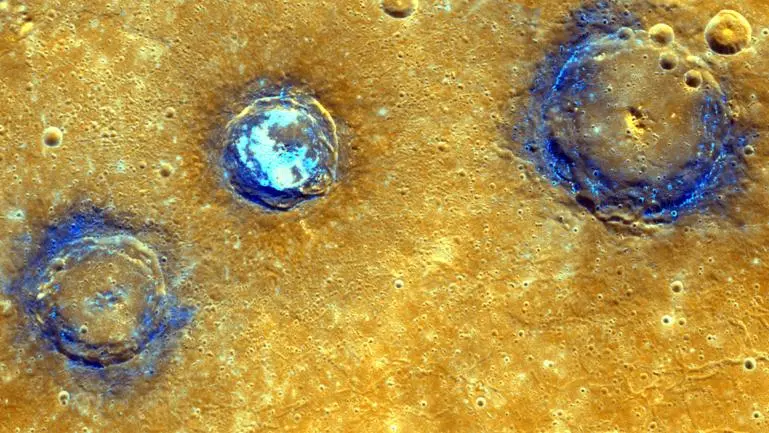Last updated on December 23rd, 2023
40. Large sheets of ice that have not been seen by the first spacecraft have been observed by a powerful telescope from Earth. Scientists believe ice has been trapped at the poles of Mercury.
41. Organic material, which is much darker than the average surface of Mercury, has been observed recently. Scientists believe these organic molecules may have been mingled with ice delivered millions of years ago.
42. Close examination of the water ice discovered on Mercury shows that it has been delivered recently and is much younger than the planet. The water ice appears mainly in the polar craters of the planet.
43. Another reason why Mercury may have ice on it is the part that is not facing the Sun is 300 degrees below zero. The craters are also always in shadow and receive no solar heat.
44. Another exciting thing is that Mercury’s tail extends about 1.6 million miles from it. At its peak, the tail stretches up to 14.6 million miles long!
45. Did you know that Mercury’s outer shell is only 400 km thick?
46. Mercury has the largest range of surface temperature found on any planet – “minus 170 degree Celsius to 430 degree Celsius.”
47. Mercury’s surface is similar to that of Earth’s moons.
48. Impact basins (an approximately circular depression in the surface of a planet, the moon, or another solid body in the Solar System or elsewhere, formed by the hyper velocity impact of a smaller body) as larger as 1550 km, in diameter, can be found on the surface of Mercury.
49. Mercury’s surface has three significant features – craters, plains, and cliffs.
50. There is a crater on Mercury that is named after the famous American cartoonist and author Dr. Suez. The crater named after him shows signs that it is relatively new.

51. At about 950 miles in diameter, the Caloris Basin is the most prominent feature on the planet’s surface. It is called a basin because it is larger than 186 miles in diameter.
52. If one would stand on the Sun-facing side of Mercury when it is closest to it, the Sun would appear three times as large when viewed from Mercury as compared to when viewed from Earth.
53. As per the observations made and data collected by the scientists, mercury has shrunken in size. It has lost 1.5 km of its diameter since its formation. This is because the planet’s interior is cooling down, causing the core to contract, and leaving much less surface space.
54. A green meteorite piece was found being sold on the streets of Morocco in 2012. Scientists discovered after studies that it matches data sent from spacecraft in orbit around Mercury.
55. According to scientists, there might be more pieces of Mercury hiding on Earth. They believe these days that Mercury was much bigger, but pieces of it had broken off and were strewn into space.
Quick facts – Mercury
| Date of discovery | Unknown |
|---|---|
| Discovered by | Known by the Ancients |
| Orbit Size Around Sun | 57,909,227 km |
| Mean Orbit Velocity | 170,503 km/h |
| Equatorial Inclination | 0 degrees |
| Equatorial Radius | 2,439.7 km |
| Volume | 60,827,208,742 cubic km |
| Mass | 330,104,000,000,000,000,000,000 kg |
| Density | 5.427 grams per cubic centimeter |
| Surface Area | 74,797,000 square km |
| Surface Gravity | 3.7 meter per second square |
| Escape Velocity | 15,300 km/h |
| Surface Temperature | minus 173 to 427 °C |
| Atmospheric Constituents | Nitrogen, Oxygen and others |
